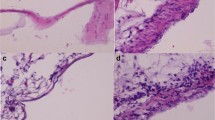Abstract
Bleomycin is the antineoplastic agent used most commonly for the treatment of malignant pleural effusion. It is absorbed rapidly from the pleural space and does not elicit pleurodesis in the normal rabbit pleura. Mitoxantrone is a new antineoplastic that differs from bleomycin in that it binds to membranes. Accordingly it might remain in the pleural space for a longer period and produce a pleurodesis. The objective of this project was to determine whether mitoxantrone is an effective sclerosant in an experimental model in rabbits. The following medications were instilled intrapleurally in anesthetized male rabbits: 35 mg/kg tetracycline or 0.5, 1.0, or 2.0 mg/kg mitoxantrone. The animals were killed at 28 days and the pleural spaces assessed grossly for pleurodesis and microscopically for fibrosis and inflammation. The mean degree of gross pleurodesis did not differ significantly in the rabbits that received tetracycline (3.8 ± 0.4) and in the rabbits that received 2 mg/kg mitoxantrone (3.2 ± 1.3). The degree of pleural and lung inflammation was significantly greater after mitoxantrone than after tetracycline, both ipsilaterally and contralaterally. The mortality after the highest dose of mitoxantrone was 50%. From this study we conclude that the intrapleural administration of mitoxantrone in rabbits can produce a pleurodesis. The histologic picture after mitoxantrone administration differs markedly from that after tetracycline injection. After mitoxantrone injection there are many more inflammatory cells present on the side that received the injection, and there is much more fibrosis and inflammation in the contralateral pleura and lung. The model of pleural fibrosis following intrapleural mitoxantrone may be useful for the study of pleural fibrosis.
Similar content being viewed by others
References
Alberts DS, Surwit EA, Peng Y-M, McCloskey T, Rivest R, Graham V, McDonald L, Roe D (1988) Phase I clinical and pharmacokinetic study of mitoxantrone given to patients by intraperitoneal administration. Cancer Res 48:5874–5877
Alderton PM, Gross J, Green MD (1992) Comparative study of doxorubicin, mitoxantrone, and epirubicin in combination with ICRF-187 (ADR-529) in a chronic cardiotoxicity animal model. Cancer Res 52:194–201
Austin EH, Flye MW (1979) The treatment of recurrent malignant pleural effusion. Ann Thorac Surg 28:190–203
Carvalho P, Knight LL, Olson RD, Crowley JJ, Hawk PA, Charan NB (1995) Effects of erythromycin on the rabbit pleura: its potential role as a pleural sclerosant. Am J Respir Crit Care Med 151:1228–1232
Dryzer SR, Joseph J, Baumann M, Birmingham K, Sahn SA, Strange C (1993) Early inflammatory response of minocycline and tetracycline on the rabbit pleura. Chest 104:1585–1588
Groth G, Gatzemeier U, Haubingen K, Heckmayr M, Magnussen H, Neuhauss R, Pavel JV (1991) Intrapleural palliative treatment of malignant pleural effusions with mitoxantrone versus placebo (pleural tube alone). Ann Oncol 2:213–215
Hurewitz AD, Lidonicci K, Wu CL, Reim D, Zucker S (1994) Histologic changes of doxycycline pleurodesis in rabbits: effect of concentration and pH. Chest 106:1241–1245
Izbicki R, Weyhing BT III, Baker L, Caoili EM, Vaitkevicius VK (1975) Pleural effusion in cancer patients: a prospective randomized study of pleural drainage with the addition of radioactive phosphorus to the pleural space vs pleural drainage alone. Cancer 36:1511–1518
Kelly J, Holmes EC, Rosen G (1993) Mitoxantrone for malignant pleural effusion due to metastatic sarcoma. Surg Oncol 2:299–301
Kennedy L, Harley RA, Sahn SA, Strange C (1995) Talc slurry pleurodesis: pleural fluid and histologic analysis. Chest 107:1707–1712
Kessinger A, Wigton RS (1987) Intracavitary bleomycin and tetracycline in the management of malignant pleural effusions: a randomized study. J Surg Oncol 36:81–83
Kuhn K, Purea H, Selbach J (1989) Treatment with locally applied mitoxantrone. Acta Med Austriaca 16:87–90
LeMaistre CF, Herzig R (1990) Mitoxantrone: potential for use in intensive therapy. Semin Oncol 17:43–48
Light RW, Wang NS, Sassoon C, Despars JA, Oliver D, Gruer SE, Vargas FS (1994) Comparison of the effectiveness of tetracycline and minocycline as pleural sclerosing agents in rabbits. Chest 106:577–582
Light RW, Wang N-S, Sassoon CSH, Gruer SE, Oliver D, Vargas FS (1995) Talc slurry is an effective pleural sclerosant in rabbits. Chest 107:1702–1706
Maiche AG, Virkkunen P, Kontkanen T, Moykkynen K, Porkka K (1993) Bleomycin and mitoxantrone in the treatment of malignant pleural effusions. Am J Clin Oncol 16:50–53
Morales M, Exposito MC (1995) Intrapleural mitoxantrone for the palliative treatment of malignant pleural effusions. Support Care Cancer 3:147–149
Musch E, Paar WD, Hoffmann B, Seitzer D, Chemassani A, et al. (1989) Intrapleurale instillation von mitoxantron zur palliativ-therapic maligner pleuraergusse. Turn Diag Therap 10:64–71
Ruckdeschel JC, Moores DW, Lee JY, Einhom LH, Mandelbaum I, Koeller J, Weiss GR, Losada M, Keller JH (1991) Intrapleural therapy for malignant pleural effusions. Chest 100:1528–1535
Sahn SA, Good JT Jr (1981) The effect of common sclerosing agents on the rabbit pleural space. Am Rev Respir Dis 124:65–67
Vargas FS, Wang NS, Despars JA, Gruer SE, Sassoon C, Light RW (1993) Effectiveness of bleomycin in comparison to tetracycline as pleural sclerosing agent in rabbits. Chest 104:1582–1584
Vargas FS, Wang N-S, Teixeira LR, Carmo AO, Silva LMMF, Light RW (1995) Corynebacterium parvum versus tetracycline as pleural sclerosing agents in rabbits. Eur Respir J 8:2174–2177
Watker-Renard PB, Vaughan LM, Sahn SA (1994) Chemical pleurodesis for malignant pleural effusions. Ann Intern Med 120:56–64
Weisberger AS, Levine B, Storaasli JP (1955) Use of nitrogen mustard in treatment of serous effusions of neoplastic origin. JAMA 159:1704–1706
Author information
Authors and Affiliations
Additional information
Offprint requests to: Richard W. Light
Rights and permissions
About this article
Cite this article
Light, R.W., Wang, NS., Despars, J.A. et al. Comparison of mitoxantrone and tetracycline as pleural sclerosing agents in rabbits. Lung 174, 373–381 (1996). https://doi.org/10.1007/BF00164634
Accepted:
Issue Date:
DOI: https://doi.org/10.1007/BF00164634




